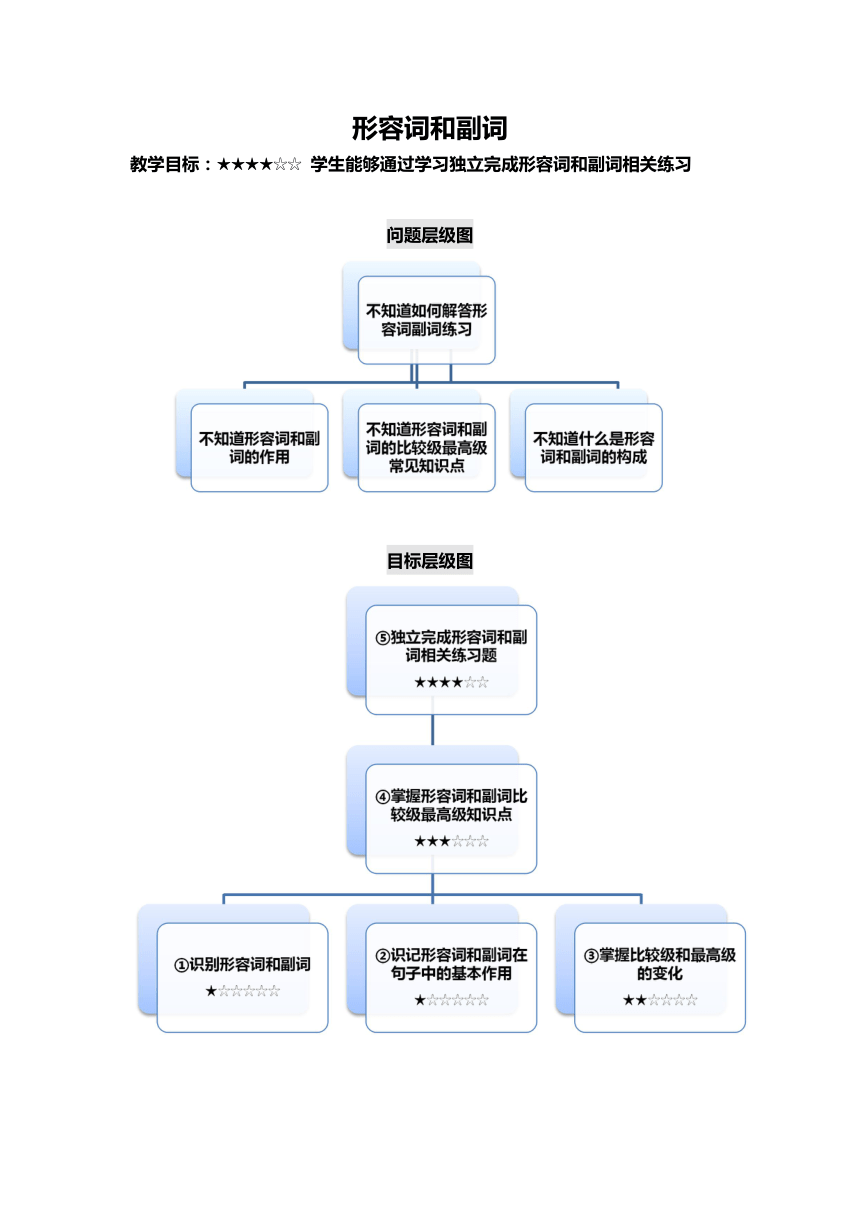
形容词和副词 教学目标:★★★★ 学生能够通过学习独立完成形容词和副词相关练习 问题层级图 目标层级图 一、识别形容词和副词 例: The man is ill. This is an interesting story. I have something important to tell you. 1.形容词的含义:修饰_____,_____.说明事物或人的性质或特征 KEYS: 名词;代词 例: He speaks English well. The girl is extremely pretty. She runs very fast. 2.副词的含义:副词主要用来修饰_____,_____,_____ KEYS:动词;形容词;副词 3. 形容词变副词变化规则: 1)一般情况直接加 “ly” quick(形容词)_____(副词) 2) 以辅音字母加“y”结尾的变“y”为“i”,加“ly” happy(形容词)_____(副词) 3) 辅音字母加不发音字母“e”结尾和以“ue”结尾的去掉“e”, 然后再加“ly” terrible(形容词)_____(副词) 4)以“ll”结尾的词,只加“y” full(形容词)_____(副词) KEYS: quickly; happily ;terribly; fully 注意 有些以“ly”结尾的词是形容词而非副词,如: friendly ; motherly; lovely; monthly ; heavenly ; manly 练习 找出下列该段中的形容词和副词 John is a polite people. Every morning he greet everybody politely. And his politesse always make us feel good. He has ever said that he hates impolite people. 形容词:_____ 副词:_____ KEYS: 形容词: polite; good; impolite 副词: politely 二、形容词和副词在句子中的作用 例: Her new dress is very beautiful. He is a good young man. I have something important to tell you. The hole is large enough. That sounds interesting. I have a good book. 1. 形容词的作用: 1)形容词可放在_____之后,作表语; 2)形容词修饰名词或代词,放在名词或代词_____,作定语。 3)形容词修饰_____放在_____. KEYS: 1)系动词 2)之后 3)不定代词; 之后 例: He works very hard. This street is very long. He speaks English well. The girl is extremely pretty. She runs very fast. 2. 副词的作用:副词可修饰_____,_____,_____放在其_____作状语。 KEYS: 动词;形容词;副词;之前 3. 副词的分类 1)表示_____副词:today, now, then, ago, before, early, late, soon等。 2)表示_____和重复的时间副词,如:always, often, never, hardly, again, once等。 3) 表示_____副词,如: everywhere, here, there, home, near, away, above, below, across, in, out, inside, up, down, upstairs, around, back, behind等。 4) 表示_____副词,如:hard, well, together, clearly, slowly, politely, suddenly等。 5) 表示_____副词,如:much, quite, rather, almost, even, just, still, nearly, only, very等。 KEYS: 时间;频度;地点和方位;方式;程度 拓展 例: two beautiful new green silk evening dress a beautiful new black Italian leather jacket 多个形容词修饰一个名词,这些形容词之间的先后顺序如何记忆有方法如下: 口诀法:"美小圆旧黄,法国木书房” (注:“美”代表“描述或性质类”;“小”代表“大小、长短、高低、胖瘦类” ;“圆”代表“形状类” ;“旧”代表“新旧、年龄类” ;“黄”代表“颜色类” ;“法国”代表“来源、国籍、地区、出处类” ;“木”代表“物质、材料、质地类” ;“书”代表“用途、类别、功能、作用类” ;“房”代表“中心名词”。) 练习 1. She has a _____ jacket. (leather,brown,beautiful) 2. He has a _____ car. (American,long,red) 3. They live in a _____ house. (old,beautiful) 4. We have a_____ table. (antique, small,wooden) 5. It was a __ ... ...
~~ 您好,已阅读到文档的结尾了 ~~